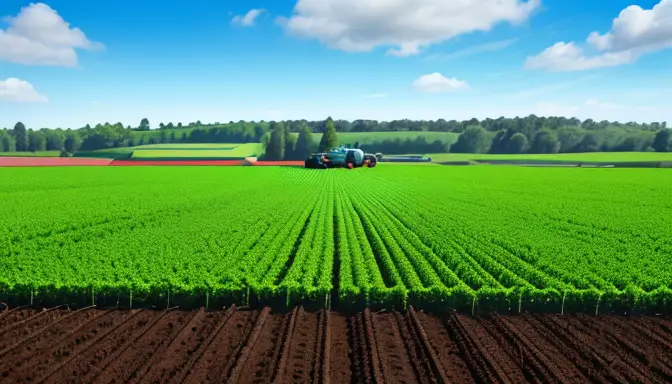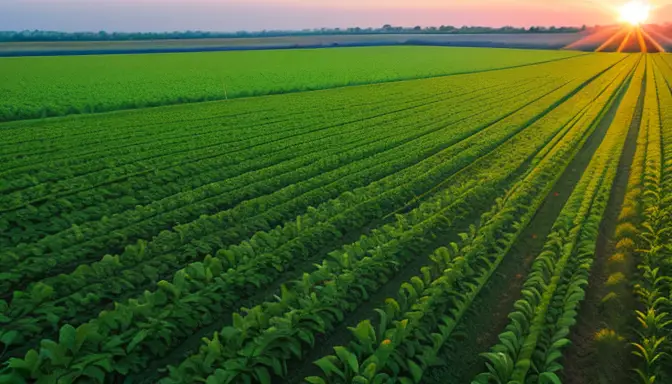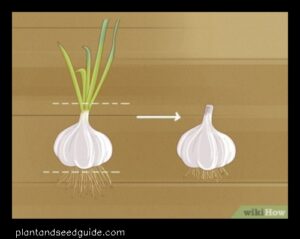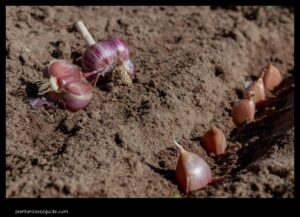When it comes to inorganic fertilizers, there is a whole world of information to uncover. From their chemical compositions to their impact on plant growth, understanding these fertilizers is crucial for anyone involved in gardening or agriculture. So, let’s dive into the realm of inorganic fertilizers and decode what you need to know.
First and foremost, it’s essential to grasp the types of inorganic fertilizers available. These include nitrogen, phosphorus, and potassium-based fertilizers, each playing a specific role in enhancing plant growth. Knowing the chemical compositions and functions of these fertilizers is key to maximizing their benefits.
When it comes to using inorganic fertilizers, the application methods and dosage are critical factors.
Finding the right balance is key.Proper techniques, dosage considerations, timing, and frequency all play a role in ensuring that plants receive the necessary nutrients without causing harm to the environment..
So, what are the benefits of using inorganic fertilizers? Their fast-acting nature, precise nutrient content, and ability to address specific soil deficiencies make them a popular choice among gardeners and farmers. These fertilizers can significantly improve plant health and growth when used correctly.
However, it’s essential to acknowledge the drawbacks and risks associated with inorganic fertilizers. Issues such as nutrient leaching, soil degradation, chemical runoff, and environmental pollution are concerns that need to be addressed. Balancing the benefits with the risks is crucial for sustainable agriculture.
How do inorganic fertilizers stack up against organic alternatives? A comparative analysis can shed light on factors like nutrient availability, cost-effectiveness, sustainability, and long-term impacts on soil health. Understanding the differences can help in making informed decisions about fertilizer choices.
Furthermore, considering the regulatory standards and environmental impact of inorganic fertilizers is essential. Compliance with regulations and awareness of their effects on soil quality, water systems, and biodiversity are crucial for sustainable agriculture practices. Striking a balance between productivity and environmental responsibility is key.
Looking towards the future, emerging trends and innovations in the field of inorganic fertilizers offer exciting possibilities. Controlled-release formulations, precision agriculture technologies, and sustainable practices are paving the way for a greener agricultural future. Staying informed about these advancements is vital for staying ahead in the world of agriculture.
Types of Inorganic Fertilizers
When it comes to inorganic fertilizers, there is a wide range of types available, each serving a specific purpose in plant nutrition. The main categories of inorganic fertilizers include:
- Nitrogen-based Fertilizers: Known for promoting leafy, green growth in plants, nitrogen fertilizers are essential for photosynthesis and overall plant development.
- Phosphorus-based Fertilizers: These fertilizers play a crucial role in root development, flower formation, and fruit production, aiding in energy transfer within the plant.
- Potassium-based Fertilizers: Potassium fertilizers help improve plant immunity, regulate water uptake, and enhance overall plant vigor and resilience.
Each type of inorganic fertilizer contains specific nutrients that cater to different stages of plant growth and development. Understanding the characteristics and functions of these fertilizers is key to providing plants with the necessary elements for robust health and productivity.

Application Methods and Dosage
When it comes to applying inorganic fertilizers, getting the dosage and application methods right is crucial for ensuring the health and growth of your plants. Whether you are a seasoned gardener or a beginner in the field of agriculture, understanding the proper techniques can make a significant difference in the effectiveness of the fertilizers. Here are some key points to consider:
- Soil Testing: Before applying any inorganic fertilizer, it is essential to conduct a soil test to determine the existing nutrient levels and pH balance. This information will help you select the appropriate fertilizer and dosage for your plants.
- Follow Instructions: Always read and follow the instructions provided on the fertilizer packaging. Different fertilizers have varying concentrations and application guidelines, so it is crucial to adhere to the recommended dosage.
- Timing: Consider the stage of plant growth and the specific nutrient requirements at different growth stages. Applying fertilizers at the right time can maximize nutrient uptake and promote healthy development.
- Uniform Application: Ensure even distribution of the fertilizer across the entire area to prevent over-fertilization in certain spots. This can be achieved through proper spreading techniques or using specialized equipment.
- Monitoring and Adjusting: Regularly monitor the response of your plants to the fertilizer application. If you notice any signs of nutrient deficiency or excess, adjust the dosage accordingly to maintain optimal plant health.
Benefits of Using Inorganic Fertilizers
When it comes to the benefits of using inorganic fertilizers, gardeners and agricultural enthusiasts are in for a treat. These fertilizers pack a powerful punch with their fast-acting nature, delivering nutrients to plants in a quick and efficient manner. Unlike organic fertilizers, inorganic options offer precise nutrient content, allowing for targeted supplementation to address specific deficiencies in soil. This precision can lead to improved plant health and growth, giving your garden or crops the boost they need to thrive.

Drawbacks and Risks
When it comes to inorganic fertilizers, it’s essential to be aware of the potential drawbacks and risks that come along with their use. While these fertilizers offer quick results and precise nutrient delivery, they also pose certain challenges that need to be carefully considered.
- Nutrient Leaching: One of the main concerns with inorganic fertilizers is the risk of nutrients leaching into the soil, leading to pollution of groundwater and surface water sources.
- Soil Degradation: Continuous use of inorganic fertilizers can disrupt the natural balance of the soil, affecting its structure, fertility, and microbial activity over time.
- Chemical Runoff: Runoff from fertilized fields can carry excess chemicals into nearby water bodies, causing harm to aquatic ecosystems and wildlife.
- Environmental Pollution: The accumulation of synthetic chemicals from inorganic fertilizers can have long-lasting impacts on the environment, affecting biodiversity and ecosystem health.
Considering these drawbacks and risks, it’s important for gardeners and farmers to use inorganic fertilizers judiciously, following recommended application practices and exploring sustainable alternatives to minimize negative impacts on the environment.
Comparative Analysis with Organic Fertilizers
When comparing inorganic fertilizers with organic alternatives, it’s essential to delve into the nuanced differences that shape their efficacy and environmental impact.
In contrast, inorganic fertilizers, synthesized through chemical processes, provide quick nutrient availability and targeted solutions for specific nutrient deficiencies in plants.Organic fertilizers, derived from natural sources like compost, manure, or bone meal, offer a holistic approach to soil enrichment, promoting long-term soil health and biodiversity..
One key factor in the comparison is the nutrient availability and release dynamics between organic and inorganic fertilizers. While organic fertilizers release nutrients slowly over time, ensuring a steady supply for plant uptake, inorganic fertilizers deliver nutrients rapidly, addressing immediate plant needs but potentially leading to nutrient leaching and runoff.
Cost-effectiveness is another aspect to consider, with inorganic fertilizers often being more affordable and easier to apply in precise quantities. However, the long-term sustainability of organic fertilizers in improving soil structure and fertility, reducing chemical dependency, and fostering microbial activity cannot be overlooked.
Furthermore, the environmental implications of both types of fertilizers differ significantly. Organic fertilizers contribute to soil health and water conservation, minimizing the risk of chemical contamination and supporting ecosystem balance. On the other hand, inorganic fertilizers may pose challenges related to soil degradation, water pollution, and overall ecological disruption.
In conclusion, the choice between inorganic and organic fertilizers depends on various factors, including the specific needs of the plants, environmental considerations, and long-term sustainability goals.
By understanding the comparative analysis of these fertilizers, gardeners and farmers can make informed decisions to promote healthy plant growth while safeguarding the environment for future generations..

Regulatory Standards and Environmental Impact
When it comes to the use of inorganic fertilizers, adherence to regulatory standards is crucial to minimize the environmental impact. These standards are put in place to ensure the safe production, distribution, and application of fertilizers while safeguarding ecosystems and public health. By following these regulations, the industry can mitigate risks associated with chemical runoff, soil contamination, and water pollution.
Additionally, understanding the environmental impact of inorganic fertilizers is essential for sustainable agriculture practices.
Moreover, the runoff of fertilizers into water systems can result in algae blooms, oxygen depletion, and harm to aquatic life.Excessive use of these fertilizers can lead to nutrient imbalances in soil, affecting plant growth and overall ecosystem health..
To address these concerns, regulatory bodies set limits on the use of certain chemicals in fertilizers, establish guidelines for proper application techniques, and monitor the quality of soil and water resources. By complying with these standards, farmers and gardeners can contribute to preserving the environment for future generations.
Future Trends and Innovations
As we look towards the future of inorganic fertilizers, exciting trends and innovations are reshaping the agricultural landscape.
This not only maximizes the effectiveness of the fertilizers but also reduces the risk of nutrient leaching and environmental contamination.One key advancement is the development of controlled-release formulations, which allow for a more precise and efficient delivery of nutrients to plants over an extended period..
In addition, the integration of precision agriculture technologies is revolutionizing how inorganic fertilizers are applied. By utilizing data-driven insights and tools such as drones and sensors, farmers can optimize the use of fertilizers, minimizing waste and environmental impact while maximizing crop yields.
Furthermore, sustainable practices are gaining traction in the realm of inorganic fertilizers. From utilizing renewable energy sources in production to implementing circular economy principles, the industry is moving towards a greener and more environmentally friendly approach to fertilization.
Frequently Asked Questions
- What are the main benefits of using inorganic fertilizers?
Inorganic fertilizers offer fast-acting nutrients, precise nutrient content, and the ability to address specific soil deficiencies for enhanced plant health and growth.
- What are the potential risks associated with inorganic fertilizers?
Some risks include nutrient leaching, soil degradation, chemical runoff, and environmental pollution concerns due to improper usage or overapplication of inorganic fertilizers.
- How do inorganic fertilizers compare to organic fertilizers?
Inorganic fertilizers are often faster-acting and have specific nutrient compositions, while organic fertilizers promote long-term soil health and sustainability with slower nutrient release.
- Wild Rose Country: Exploring Untamed Beauty - July 15, 2024
- Wildflower Nursery Decor: Bringing Nature Indoors - July 15, 2024
- Young Sprout of Grass: Nurturing New Life - July 15, 2024









